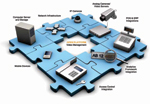
Contemplating the Cloud
The cost of storage, mobile access demands will define the future of hosting
- By Eric Fullerton
- Jan 03, 2011
Eventually, hosting will happen. And the
video management software application
will continue to have a central role in
video surveillance because, by its nature,
video gathers a lot of data input.
That data is going to be stored either
on the camera, on a local server, pulled
back to a central server or pulled into
the cloud. But hosting is not going to
change the importance of video management --
just the way it happens.
People are still going to want and
need to continue to use all the great
VMS features and functionality that let
them work with their video data today.
It’s just a difference of how the data
comes from the cameras into the user
client of the VMS and how it is controlled
and stored.
The Cost of Bandwidth
The cost of bandwidth is going to
fall, and at a certain time when there’s
enough low-cost bandwidth available,
hosting will start to happen on a wider
scale. The single biggest inhibitor for
the hosting model today is the cost of
bringing the video into the cloud. What
happens when you bring the video surveillance
into the cloud is that it adds
more cost to the stored video in a surveillance
system. This indirectly and
negatively impacts the total cost of
ownership and return on investment
calculation for operating a video surveillance
system.
Some people say that not more than
half a percent of all video is ever viewed
after it is recorded; others think it could
be as much as 5 percent. So if hosting
is to bring all this video into the cloud
for storage, in reality you are adding
cost to 100 percent of the video when
you are interested in only a maximum
5 percent of it. So when you are using
up to only 5 percent of that video, the
accumulated cost of the total storage in
the cloud would be prohibitive at this
time because only 5 percent of it has to
carry the cost of 100 percent of it.
One scenario to improve this cost
dilemma could be to have only smart
cameras -- with analytics on board to
define which video segments need to
be sent to storage. But if you look at
the nature of the way people use video
today, they always like to have access
to whatever was recorded. Therefore,
there might be some improvements doing
local recording at the edge to lift
only a certain amount of the video into
the cloud for later viewing. Still, that’s
not the way people are using video now.
The Tipping Point
The real enabler of hosting will be the
day when the cost of using a hosted solution
is equivalent to the cost of doing
local storage and centralized management
in private networks -- this is very
similar to what enabled hosting for the
IT data world in the 1990s.
There was a cut-over phase when the
cost of putting the data into the cloud
became lower -- that started fueling the
whole cloud computing trend, where
the tipping point will be for video to
be cost efficient in the cloud. We don’t
know yet.
Mobility is another driver that
will influence hosting. Devices such
as smart phones and tablets are significantly
changing the way people do
things. But that’s just on the user-client
side, in the way people want to access
their data.
For video data, we’ve already enabled
remote access through the Internet
or private access through VPNs
without going into what is defined as
hosting. So mobility is driving a new
way of accessing and using video, but
it is not necessarily driving true hosting
in the cloud. It could be one of the
elements that have to be in place for
hosting to happen -- as people expect to
have full access to full-featured video at
any place and any time.
As we move forward, there will be
video stored in cameras, in local servers,
in central servers and, eventually, in
the cloud. The demand on a video management
system in the future will be to
give people seamless access to whatever
video there is at the point of a fingertip
with maximum usability.
This article originally appeared in the January 2011 issue of Security Today.